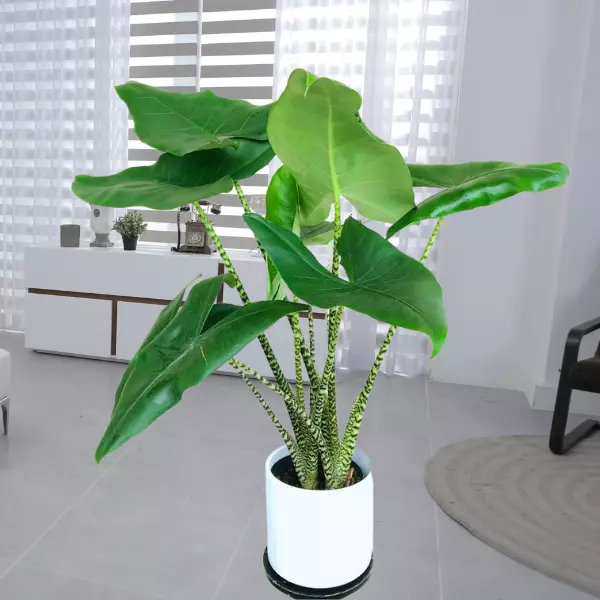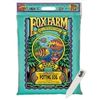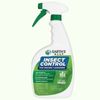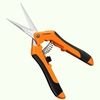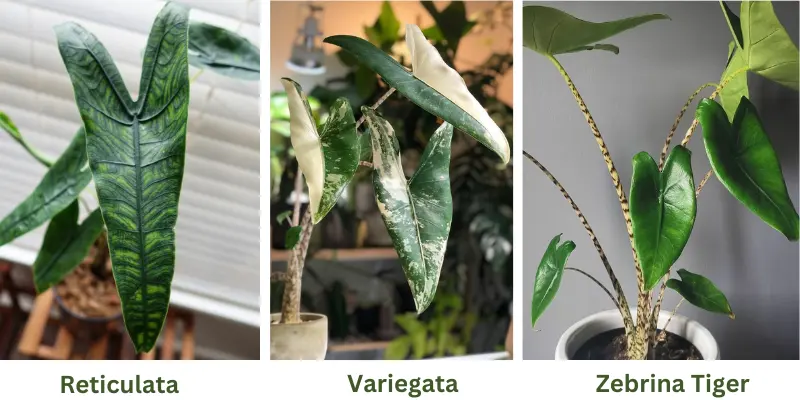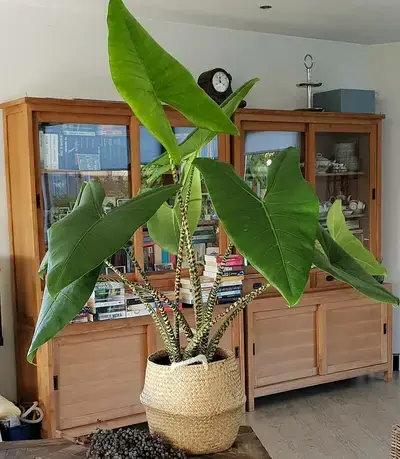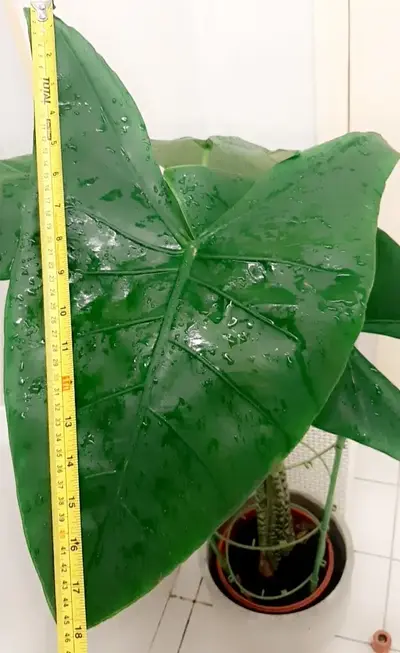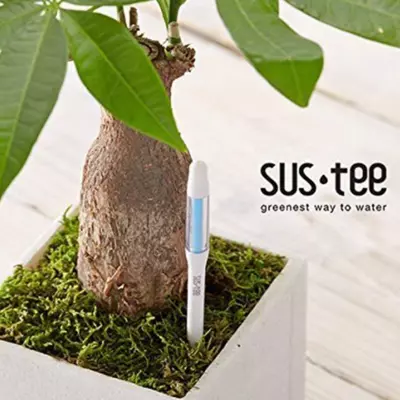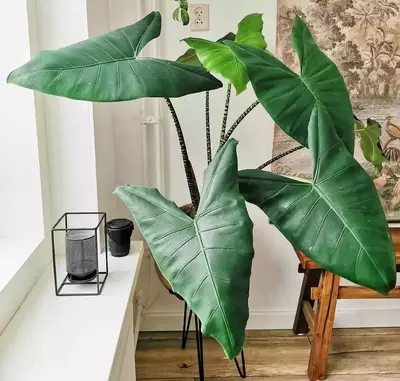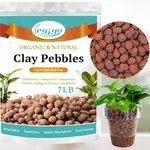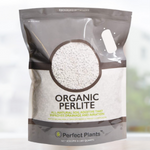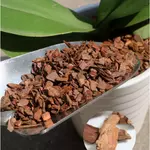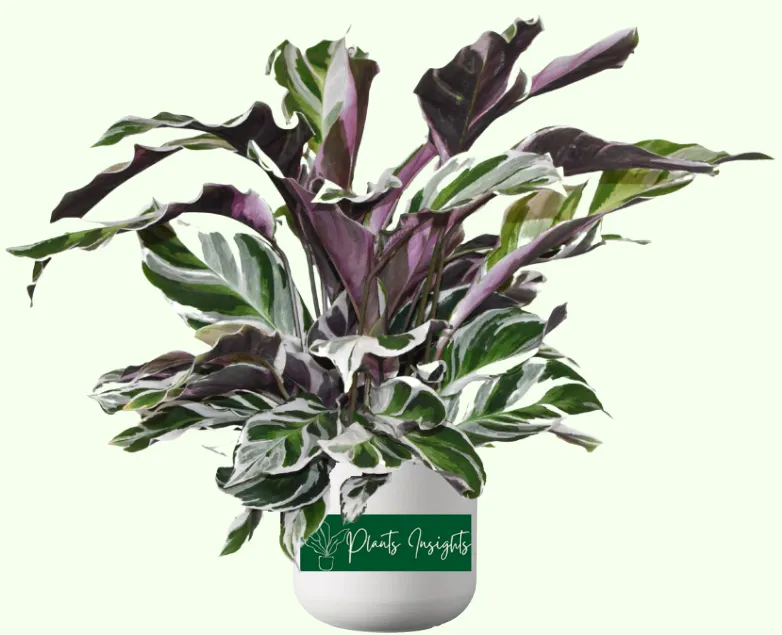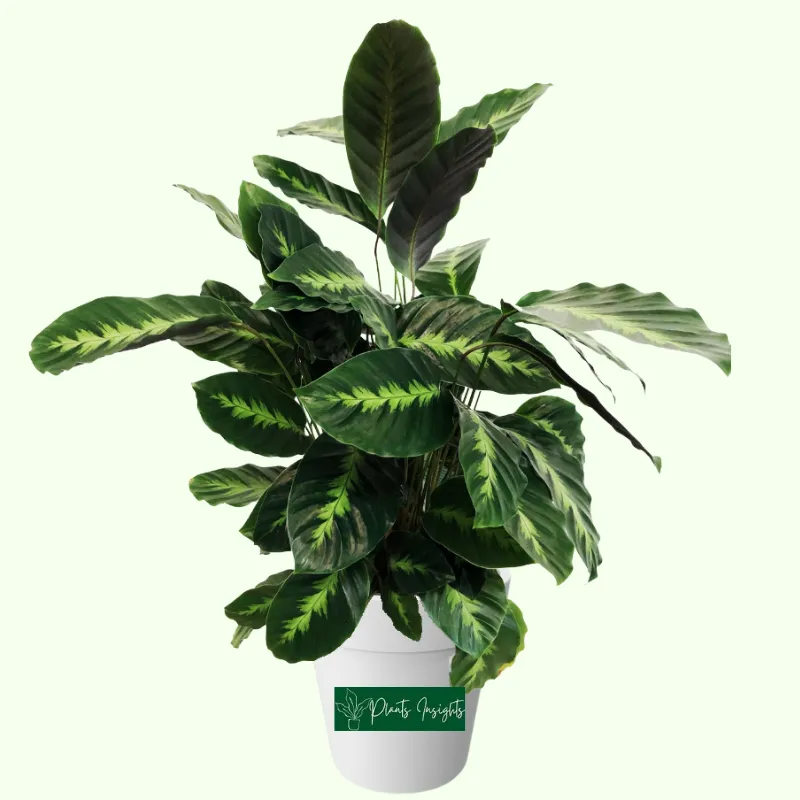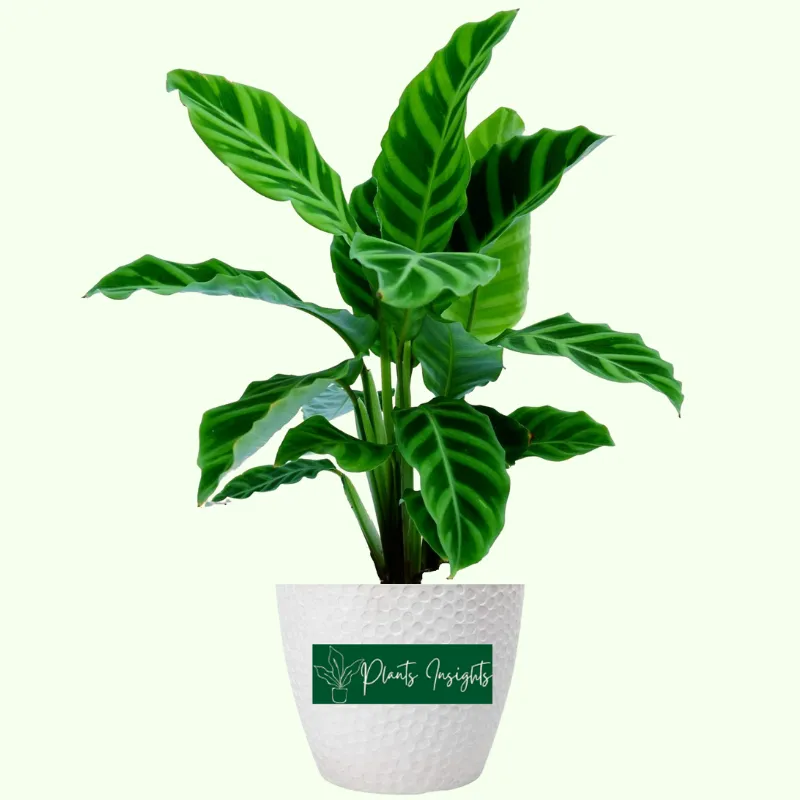Alocasia Zebrina is stunning tropical vegetation and serves as exotic ornamental beauty indoors and outdoors. Unlike other Alocasias, the highlight of the plant is not the foliage but the striking zebra-like striped stems or petioles. Zebrina Alocasia features the iconic striped petioles that every plant lover is so in love with these days. The prominent petioles are striped green and white, growing large arrow-shaped leaves at the tips. The outlandish petioles manifest this large, leafed plant as an eye-catching and tremendous, extravagant piece. Zebrina’s large leaves and unique zebra striped petioles have earned this Alocasia many names, such as Zebra Alocasia or Elephant ear Zebrina and a local name Gabing tigre in Tagalog.
Allied Species: Alocasia Macrorrhiza Variegata, Alocasia Sarian, Alocasia Pink Dragon, Alocasia Cucullata, Alocasia Silver Dragon, Alocasia Stingray, Alocasia Regal Shields, Alocasia Nebula, Alocasia Maharani, Alocasia Jacklyn , Alocasia Macrorrhiza.
However, this magnificent beauty is not the easiest Alocasia to take care of; it happens to drop leaves from time to time which is quite normal with many Alocasias. Provided this plant with optimal care may reduce the dropping of leaves, and it’ll only drop its old leaves to make room for large new leaves. After all, Alocasia Zebrina is minimalistic in leaves, and we don’t want to lose any leaves.
Essential Products
Habitat & Ecology
The Alocasia Zebrina is a tropical ornamental plant in the family Araceae. It is native to tropical and subtropical regions of Southeast Asia, specifically the islands of Luzon, Samar, Mindanao, Biliran, and Alabat in the Philippines. This tropical aroid can make an eminent ornamental indoor plant but can also be grown outside under certain conditions. The Zebrina Alocasia is listed as a threatened or endangered plant due to overcollection in the wild but tissue culture has eliminated its risk of being extinct.
| Botanical Name: | Alocasia Zebrina |
| Family Name: | Araceae |
| Common names: | Zebra plant, Zebrina Alocasia, Tiger Taro (gabing tigre), Zebrina Leopard |
| Origin | Southeast Asia-Specific Philippines |
| Variants | Zebrina Tiger, Zebrina Variegata, Zebrina Reticulata |
| Plant Size | 5.9 ft long and 3 ft wide |
| Temperature | 60F-82F |
| Humidity | 60% and above |
| Light Need | Bright indirect sunlight |
| Soil Type | Moist but well-Drained- Acidic, neutral |
| Plant Type | Rhizomatous or tuberous perennials |
| Flower Inflorescence | Insignificant 16 cm long Green and White inflorescence followed by orange-red fruits |
| Propagation | Basal Offset Division, stem or tuber cutting |
| Pest and diseases | Spider mites, Aphids, Scale |
| Diseases | Root rot, leaf spot diseases |
Popular Variants of Alocasia Zebrina Cultivar
An exciting news for plant enthusiasts is that Alocasia Zebrina has many beautiful and eye-catching varieties. These variations can carry official-sounding names: Alocasia Reticulata Zebrina, Alocasia Wenzelii, and Alocasia ‘Tigrina Superba’ but all are called Alocasia Zebrina. These variants may differ in foilage colouring, differing width or thicknesses and has led to a proliferation of mutiple names for this cultivar. Here are the most prevalent types are;
Alocasia Zebrina Variegata
It’s a unique Zebrina Alocasia exhibiting green-white variegated foliage and green-patterned petioles, making it the most exceptional looking among its family. This variety of Zebrina can grow up to 1.5 meters. It is relatively rare; although the green variant is prevalent, the variegated variant is slightly more unique. It thrives well in bright light, organic, and aerated potting mix, prefers to be kept in slightly moist soil, and loves a humid environment.
Alocasia Zebrina Tiger
The Zebrina Tiger exhibits arrow-shaped leaves and distinctive, tiger-striped petioles resembling tiger fur. The tiger Zebrina also features patterned stems and wavy edged deep, glossy textured leaves. It can grow up to 1 meter.
Alocasia Zebrina Reticulata
Alocasia Reticulata, also known as Alocasia Zebrina Leopard, is a rare kind of Alocasia adored for its pretty, narrow, elongated, and green-yellow patterned colouration foliage. This Zebrina is known as Reticulata because its leaves exhibit a net-like pattern (deep green with blends of light green). Reticulata is a Latin word meaning net veined, netted or marked with net-like patterns. The foliage has an odd colouration effect, a rare feature for any plant you won’t find in other Alocasias. This unique plant is rare and often cannot be found in the wild.
Alocasia Zebrina Reticula are perfect for adding some texture and colour to your gardens or your indoor plant collection. The Reticulata are very rewarding if the plant lovers mimic its exotic topical conditions. They can grow 3 to 5 feet tall in optimal conditions, making them great houseplants thanks to their manageable size. The arrow -shaped leaves can grow 12 to 14 inches long featuring prominent deep green venation.
However, the primary care for all the variants is the same; this guide will cover all the essential care tips you need to know to keep Zebrina Alocasia happy.
How do you take care of Alocasia Zebrina?
The Alocasia Zebrina is a tricky plant to grow as they are known to be notorious for being picky about their growing conditions. Alocasia Zebrina can be a bit challenging for some growers and certainly not for beginners or people with a brown thumb. However, Zebrina is a rewarding plant if taken care of and provided with the correct nurturing environment. It sure will add a classy and fancy look to any space.
It’s tacit that Alocasia Zebra loves warm and humid conditions being a tropical plant. It will thrive if you mimic its tropical conditions like indirect or filtered light and high humidity. The Zebrina also appreciates warm temperatures and moist but well-draining soil. It needs fortnightly feedings during the growing season.
Zebrinas enjoy weekly or once in ten day watering routine and frequent misting, keeping the soil moist but not soggy. This article includes a comprehensive guide of care routines of Alocasia Zebrina at home.

Is Alocasia Zebrina fast-growing?
The evergreen, lovely Alocasia Zebrina can grow up to 1.5 meters (5 to 5.5 feet) tall, featuring beautiful arrow-shaped leaves and patterend petioles. Coming to the leaf growth of the zebra plant, the leaves grow up to 18 to 20 inches in length. Providing the optimum growing environment, it can blossom beautiful unisex flowers, but it’s scarce for this plant to grow flowers indoors. Usually Zebrina bloom in pairs and can be pollinated to produce seeds.
The beautiful zebrina can be considered a fast grower in the growing season. It grows new leaves every other week in ideal conditions. Zebrina Alocasia drop off old leaves to grow new leaves.
Flowering
Although the highlight of Alocasia zebrina is not the blooms, Zebra plants tend to produce inflorescences in pairs in the late spring. The inflorescences are hooded green spathes surrounding a white, stick-like spadix. Well actually their spathe isn’t technically a flower (botanically speaking) but a cover for the spadix that holds a myriad of tiny blooms along its length. In reality, the flowers themselves are almost microscopic.
Moreover, you can pollinate Alocasia inflorescences, followed by red or orange berries which ripen to produce seed.

How often do you Water Alocasia Zebrina?
Watering frequency depends on certain factors such as size of the pot and its material. Plants in a clay pot would require more water than plants in a plastic pot because of the porous nature of clay. Another factor that will influence the watering would be light. If your plant is in a higher light situation meaning your plant will photosynthesize more and use more of the water available in the growing media. Hence, watering really has many variables so it’s important just to keep your eye on them get to know your plant and consider the environment in which you place your Zebrina.
Determine Soil moisture
Zebra plant likes moisture but doesn’t want to be sitting in wet soil. So water the plant frequently in small quantities instead of drenching the soil to prevent rhizome or tuber rot. The trick is to slightly underwater it as the stems retain moisture; it should only be watered when the top two inches of the soil is dry or when the plant pot’s weight feels light (the plant weight can be checked by lifting the pot). Unless your potting mix soil is very chunky and exceptionally well-draining, we suggest not thoroughly douse the soil to flush it every session as it may lead to overwatering and make plant susceptible to root rot. The ideal time to water your Zebrina is on the cusp of soil dryness.
Overwatering can cause leaves turning yellow and the cells begin to blister. Zebrina’s main vulnerability in containers is a rhizome or tuber rot in wet soil.
On the other hand, underwatering result in the plant’s dryness. The leaves become crispy and get dry. Similarly this plant is not drought tolerant, and may suffer with browning of leaf edges due to extended dryness. Extended droughts can also trigger the Alocasia to enter a dormancy cycle.
Watering By Feel
To get an idea if your Zebrina needs watering, pick up the plant pot to feel how heavy it is. However, this method is effective for people who pick their pots regularly and also for smaller pots. Get to know the weight of your plant’s pot, and with time you can just lift the pot and can tell if it needs watering.
Another sign of your plant’s thirst is that Zebrina leaves start drooping and wilting. However, Zebrina petioles, when they grow long, tend to descend due to large, heavy leaves.
The Dormancy Factor
In the winter months, you might need to cut down the watering frequency due to the decreased light levels and the longer nights, resulting in your plant not photosynthesizing as much as in the warmer months. This means your plant is not taking up as much water from the growing medium. The plant becomes dormant during winter and susceptible to root rot if watered frequently.

Light Need
In the wild, Alocasia Zebrina loves bright filtered light under the jungle canopy. Its colossal foliage resembles solar panels trying to absorb bright indirect sunlight under the shade of the trees. Zebra plant prefers direct morning or evening less intense sunlight but remember that they don’t enjoy full afternoon sun because it may burn the plant’s foliage. They enjoy sitting in a bright window but if you put this beautiful plant in medium to low light, it will not thrive. Bright indirect light helps Zebrina grows huge elephant ear leaves and appealing patterned petioles.
Zebrina appreciates several hours of bright, indirect sunlight, preferably from a north- or east-facing window. You can put your Zebrina directly in front of the window to maximize the light it receives. For West or south-facing windows, we recommend keeping your plant a couple of feet away from the window to avoid any harsh direct sun rays. Using a sheer curtain or window film reduces the light intensity.
Tiger Taro is sensitive to leaf burn if it is exposed to too much resulting yellowing of leaves, which harms its health and development. On the other hand, drooping leaves indicate low light; if you notice wilting leaves, move the plant to a brighter location.
Plant rotation from time to time is significant, as it craves sunlight, and when it doesn’t receive adequate light, the stems start to grow longer to find sunlight which means that the plant grows leaning towards the light source.

Humidity and Temperature
Alocasias do well in humid conditions due to their tropical habitat. However, Alocasia zebrina can tolerate a slightly dry atmosphere when watered correctly and provided with bright indirect light. If your plant exhibits dropping, curly leaves, browning leaves or crispy edges, it is a sign that the plant is struggling with low humidity. In that case, move the plant to a naturally humid room of the house like the kitchen, laundry room and bathroom or place a humidifier close to the plant. The ideal humidity levels for Alocasia zebrina are 60% or above.
Moreover, to elevate the humidity, you can place your plant on a pebble tray filled with water or place a tray with water near your plants. When placing your pot on a pebble tray, keep the water low to keep the soil dry; otherwise, the soil will soak up the water from the drainage holes.
Another effective method is grouping your plants to increase the humidity due to transpiration. But avoid crowding your plants because they need airflow; else may suffer from fungal leaf spots or pest infestation spread.
The zebra plant thrives in warm conditions; it is intolerant to cold temperatures and may lose the leaf if exposed to even a slight. The preferred temperature range for Zebrina is 60ºF (15ºC) to 82ºF (28ºC). Zebra plants can be planted outdoors in USDA Zones 10-11 in sheltered spots.
For the healthy growth of this plant, avoid sudden temperature changes, including cold and hot drafts. Additionally, the plant may become dormant if the temperature falls below the ideal range. Moreover, Zebrina plants are intolerant to frost, so bring your plant indoors during winter.

Soil Requirements
Being a forest dweller, it grows in humus-rich soil layered over a rocky substrate which is chunky and airy. Like other Alocasias, Zebrina prefers airy, moist, and well-draining soil. Plant roots need aeration and may struggle in a dense, soggy medium.
Alocasia Zebrina plant are heavy feeders; hence, a nutrient-rich and well-draining soil is ideal for them to thrive. The nutrients help the plant blossom, and drainage prevents the Zebrina from root rot and other diseases. Plus, the Alocasia Zebrina Tiger thrives well in acidic soil.
Note: The organic material will decay over time and eventually causes soil compaction. A compact medium reduces airflow to the roots and encourages root rot. Therefore, we suggest inorganic components such as perlite, pumice, or coarse sand in your potting mix to keep the medium airy. The only caveat about adding inorganic components is that they don’t add beneficial nutrition; you need frequent fertilizing to provide the nutrients.
We recommend forest floor potting mix for Alocasia Zebrina, but if it’s not available, you can add following components to make nutrient rich chunky potting mix.
However if you want a ready made potting mix from the market , we highly recommend checking the following potting mixes;
Growing In Hydroponics
Hydroponics is growing your plant in a soil-less medium such as water, LECA, or PON. Although the Alocasia Zebrina is susceptible to root rot but seems to enjoy growing in water. The roots of Alocasia certainly need access to oxygen and in a hydroponic system, most oxygen used in root uptake is in the nutrient solution. Therefore, water can allow more gas exchange than sodden potting mix.
Moreover, many plant parents put their struggling Alocasia Zebrina in water to revive and root an offset for propgation. For LECA and PON mediums we recommend using self-watering pots.
Follow the following steps to grow your Zebrina plant in water, LECA, or PON.
Related Products
Products | Name | Check Price |
Organic Perlite for Plants | ||
WONDER SOIL Organic | ||
Orchid Potting Bark Mulch |

Potting & Repotting
Aroids like aeration to the roots and stay problem free in a pot with drainage holes. For Zebra plants, choose a pot one size bigger than the root ball size as they prefer to be bound in the pot. Larger pots make Zebrina suseptible to root or tuber rot as the soil will stay soggy and deficient in oxygen flow.
Alocasia Zebrina prefers to snug in their pot and might not need frequent repotting. Moreover, Alocasia is sensitive to repotting, and their fragile roots may go under shock due to repotting. Elephant Ear Zebrina needs repotting every 2 to 3 years when it outgrows its container and roots start circling the pot’s wall. Moreover, don’t rush repotting your new Alocasia Zebrina; let it acclimate to its new environment before transplanting.
The best time to repot the plant in early spring, an active growth season, and the plant needs less time to adjust to the new place. Wait for your Zebra plant to pot rebound before rejuvenating.
How to Repot?
Follow these steps for transplanting the Zebra plant.

Propagation of Zebrina Plant
The Alocasia Zebrina is a tuberous plant that produces clumps with three or four petioles. Zebrina plants can be easily propagated in various ways, such as through the tuber or stem cutting, offset division and corm method.
Propagation through Tuber Cutting
Alocasia Zebrina grows long tuber that comes out the soil surface as the plant ages with multiple growing eyes and roots. When using the tuber cutting method, scrutinize the roots for possible root rot and other diseases and trim the infected ones.
Propagation through Corms
Follow the steps below to propagate the plant through corms;
Propagation By Division
If you closely notice your Zebrina plant, they usually come with two or more main shoots in one pot, meaning multiple plants in a pot. If you don’t mind a less bushy plant, you can separate multiple plants and pot them in separate containers. Carefully untangle the roots; if the individual plants’ roots are too entangled, carefully cut them apart with a sterilized knife or scissors. Plant the separated Zebrina plants in a well-draining potting mix.
Propagating Offsets
Alocasia Zebrinas grow offsets (small plants grown from corms in the roots) next to the mother plant and can be separated from the mother plant. The offset usually has small developing roots that may entangle the mother plant; gently pull the plantlet roots and separate the offset from the mother plant. Either transplant the offset in soil, sphagnum moss or water, depending on the size and health of its root.
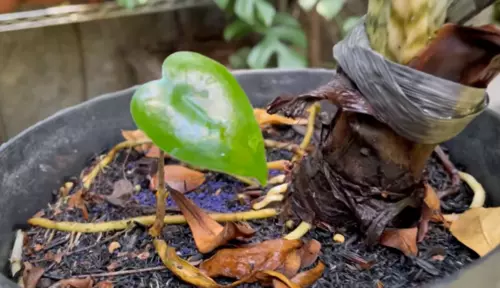

Fertilizer
The elephant ear zebrina is a heavy feeder and needs frequent fertilization during growing season. Along with the nutrient-rich potting soil, fertilize your plant with a liquid fertilizer once a month in the spring and the summer when the plant is active. Fertilizer provides additional nutrients that help to build the immune system of the Zebra plant. Avoid fertilizers in winter as it’s not an active growth season, and the plant doesn’t need extra nutrients.
It’s recommended to feed your plant every two weeks with a ½-dilution of a balanced liquid fertilizer. Some plant parents prefer granular slow-release fertilizer once a month. It releases nutrients slowly when the plant is watered and lessen the chances of foliage or root damage.
Unwanted salt residues can build up over time due to fertilization. Don’t forget to flush out excessive fertilizer every few months by flushing your plant’s soil thoroughly and letting the water drain out completely. The water drenching method keeps the soil healthy and rich. Moreover, the organic fertilizers are gentle, safe, and help increase the soil’s microbial health.

Maintenance and Pruning
The zebrina needs frequent pruning as it keeps shedding older leaves to grow new ones. It would be best to prune yellowing, dry or damaged leaves using a sterilized knife or scissor. You can sterilize your tools by dipping them in isopropyl (rubbing) alcohol. Moreover, the sap of Zebrina can cause skin irritation, so it is recommended to use gloves while pruning or repotting.
Remember, Zebrina Plant will not become bushier by frequent pruning. It can have long petioles and 3 to 4 leaves at one time. To grow new leaves, it drops off older and outer ones.
As the Zebrina plant has a few leaves, one might not want to prune the leaves unless necessary. However, to encourage growth, the best time to prune your Zebrina is the growing season when the temperature is above 80ºF (27ºC).
Note:
- Don’t trim zebra plants for decorative purposes, as the plant recurrently sheds old leaves and grows new.
- When pruning the leaves, cut foliage back close to the petioles leaving the older petioles because new leaves grow from them.
- Don’t cut the petioles at the base.

Toxicity
Alocasia Zebrina is toxic to humans and pets. It releases sap from the stem that irritates the mouth and skin. If it’s ingested, it can cause stomach problems. To enjoy this beautiful plant’s presence in your home, it’s essential to keep it away from pets and children.

Pests, diseases & common problems
Pests
Usually, this plant is prone to spider mites and Mealy Bugs. However, plant can be subject to other pest infestations such as aphids, scale, or mites. Regularly inspect the foliage and petioles for any pests. The plant may display yellow leaves and starts to drop leaves when pests attack it.
The pests can weaken the plant if they are left untreated. If your plant is infested treat it with insecticidal soap or light horticultural oil. Wash your plant foliage and thoroughly apply the soap or oil to make sure it must encounter the pests to be effective. Repeat this every 5 to 7 days until pests are eliminated.
Diseases
A common disease associated with Alocasia Zebrina is root rot. It is extremely common in Alocasias. Overwatering is the primary cause of root rot. It’s a severe condition and can kill your beloved plant. To prevent root rot, maintain a balanced watering schedule and only water the plant when the soil dries .
The typical signs of root rot are yellow leaves and mushy roots; if you suspect your plant has root rot, remove it from the pot and check if it has mushy roots. Remove mushy parts and repot the plant in a new container with a well-draining potting medium.
Common Problems
Most common issues that the Alocasia Zebrina may encounter are;
Brown patches on leaves
The appearance of brown patches on zebrina’s leaves are caused by dehydration. To combat this issue, give your plant a little bit of moisture.
Brown leaf tips and edges
If the leaves have brown edges, it is because of low humidity. This problem is more prevalent in winter because of dryness in the atmosphere caused by heaters. To provide the appropriate humidity levels, run a humidifier near the plant. If you don’t have a humidifier, misting is a good and effective alternative.
Brown patches and washed-out leaves
This problem could be initiated due to your plant being in direct sunlight. Alocasias love bright, indirect light but don’t appreciate any direct sunlight. If you spot this issue, move your plant in indirect light for a healthy and prosperous plant.
Yellow Leaves on Alocasia Zebrina
Yellowing leaves can be instigated for several reasons.
Molds on the soil
The molds on the surface of the potting soil could be caused by two reasons, low light, and overwatering. To contest this issue, replace the top 2 inches of soil and move your plant to a brighter location. Moreover, adding chunky components such as orchid bark or pumice will help.
Wilting leaves
The wilting leaves are a sign that your plant is getting too much moisture with too little light, which decreases photosynthesis and results in your plant not taking up water from the growing media.
Fungal spots
Overwatering can trigger fungal issues, including leaf-spot disease and botrytis. If your plant is in a crowded spot and doesn’t have adequate air circulation it may cause fungal spots on the leaves. Stop misting your plant and place it in a place with enough air flow.

Frequently Asked Questions
What is the best place to put an Alocasia Zebrina?
Alocasia Zebrina is a tropical plant and needs a lot of light. It cannot survive in dark areas, so choose a bright spot for your Zebrina where it receives indirect light throughout the day. You can also keep it in direct light, but it shouldn’t be more than 4 hours a day; morning direct light is the best for its fast growth.
Is Alocasia Zebrina an indoor plant?
The Zebra plant is an indoor plant that can also grow outdoors under correct conditions. However, the plant thrives indoors in a warm and humid environment with plenty of indirect light.
Is Alocasia Zebrina rare?
Alocasia zebrina belongs to the tropical rainforests of the Philippines, where it grows on rocky grounds and a thin layer of soil. It was over-harvested in the wild and was collected from there. Therefore, it can be considered a rare plant, although many nurseries grow it through propagation and tissue cultures.
Is Alocasia Zebrina easy to care?
Alocasia zebrina is not an easy plant to care for and can be challenging for the plant parents. It needs a particular environment and conditions to grow. If you are looking for an easy-growing Alocasia, you shouldn’t opt for zebrina.
Why is my Alocasia Zebrina not growing?
Many factors could hamper zebra plants’ growth, such as overwatering, underwatering, lower humidity levels, temperature fluctuations, and over-exposure to sunlight. Other factors, including improper potting soil and pest attacks, are also equally liable for the slow or no growth of a plant.
Why is my Zebrina Alocasia dying?
If your plant has yellow or droopy leaves, it’s a sign of overwatering and can cause plant loss. Therefore, it’s essential to pay special attention to the watering frequency to prevent the plant from any damage and death.
Can I put my Alocasia Zebrina outside?
Alocasia Zebrina can be put outside in a warm and sheltered spot as it can’t tolerate extreme weather conditions and freezing weather which can cause dormancy in this plant.

Final Words
Alocasia Zebrina is a beautiful ornamental plant with striped stems and large arrow shaped leaves. Plant enthusiasts adores Zebrina for its appearance, as it can lighten up any space it’s paced in.
It’s not an easy-care plant and is picky about its surroundings, but it can reward you with unique patterned petioles and large foliage under optimal conditions. This elusive plant needs your special love and care to flourish.
What are you waiting for? Bring this beauty home and escalate your home environment.
Related Posts
Calathea Musaica | Network Calathea Care Guide
Calathea Musaica is also famous as famous as Network Calathea due to its characteristic mosaic pattern like a complex network on its foliage.
Calathea Fusion White Care Guide
Calathea Fusion White is a gorgeous but difficult plant with white color fusing with green on glossy leaves and purple color undersides.
Calathea Louisae Maui Queen Care Guide
Calathea Louisae also known as Calathea Maui Queen require little care to be an adoring, colorful plant boasting exotic beautiful foliage.
Calathea Zebrina | Calathea Zebra Plant Care Guide
Calathea Zebrina, the Zebra plant is a plant with dark green velvety leaves and lime green stripes giving it a pattern look of Zebra.
Rattlesnake Plant | Calathea Lancifolia Care Guide
Calathea Lancifolia gets the nickname of Rattlesnake plant due to the markings on the leaves that resemble rattle snakeskin patterns.

